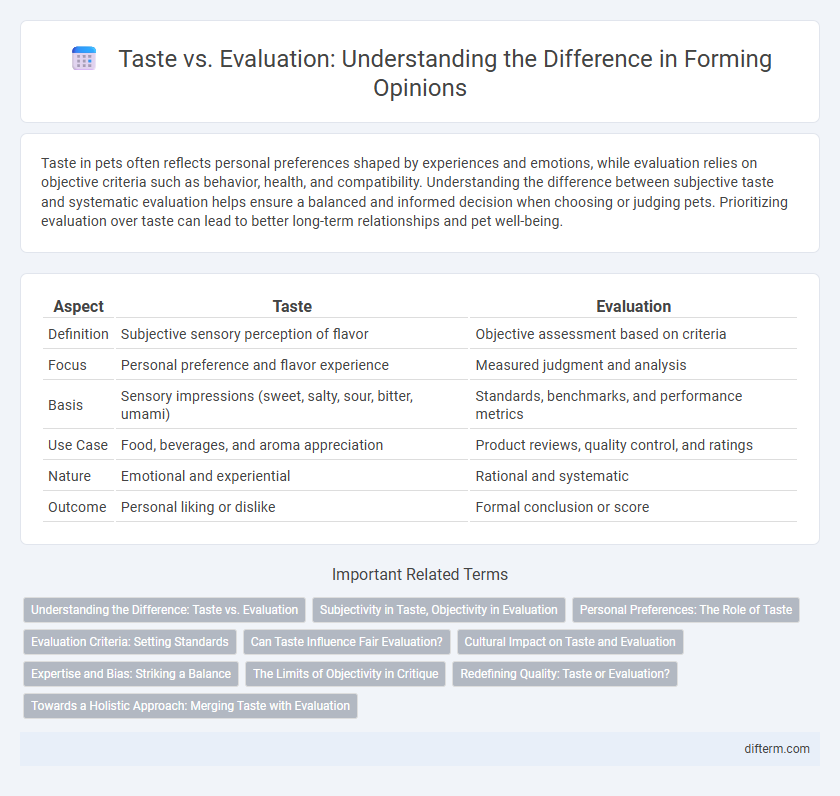Taste in pets often reflects personal preferences shaped by experiences and emotions, while evaluation relies on objective criteria such as behavior, health, and compatibility. Understanding the difference between subjective taste and systematic evaluation helps ensure a balanced and informed decision when choosing or judging pets. Prioritizing evaluation over taste can lead to better long-term relationships and pet well-being.
Table of Comparison
| Aspect | Taste | Evaluation |
|---|---|---|
| Definition | Subjective sensory perception of flavor | Objective assessment based on criteria |
| Focus | Personal preference and flavor experience | Measured judgment and analysis |
| Basis | Sensory impressions (sweet, salty, sour, bitter, umami) | Standards, benchmarks, and performance metrics |
| Use Case | Food, beverages, and aroma appreciation | Product reviews, quality control, and ratings |
| Nature | Emotional and experiential | Rational and systematic |
| Outcome | Personal liking or dislike | Formal conclusion or score |
Understanding the Difference: Taste vs. Evaluation
Taste reflects an individual's subjective preferences shaped by personal experiences and cultural background, while evaluation involves objective criteria and critical analysis to assess quality or value. Understanding the difference highlights how taste is inherently emotional and intuitive, whereas evaluation requires systematic judgment based on standards and evidence. Recognizing these distinctions enables clearer communication and more balanced discussions in artistic, culinary, and consumer contexts.
Subjectivity in Taste, Objectivity in Evaluation
Taste is inherently subjective, shaped by personal preferences, cultural background, and individual experiences, making it unique to each person. Evaluation strives for objectivity through standardized criteria, measurable qualities, and consensus-based judgments to provide consistent assessments. Balancing subjective taste with objective evaluation enables a nuanced understanding and appreciation of art, food, or any sensory experience.
Personal Preferences: The Role of Taste
Taste shapes personal preferences by influencing how individuals perceive flavors, textures, and aromas in food, art, or experiences. Subjective enjoyment hinges on unique sensory responses, making evaluation inherently individual and resistant to standardized judgment. Personal taste serves as a crucial filter through which people assign value, highlighting the importance of diversity in opinions.
Evaluation Criteria: Setting Standards
Evaluation criteria establish objective benchmarks that transcend subjective taste, enabling consistent assessment across diverse preferences. These standards quantify quality and performance, offering a structured framework for fair comparison. By setting clear metrics, evaluations minimize bias and foster transparency in judgment.
Can Taste Influence Fair Evaluation?
Taste often shapes individual preferences, yet fair evaluation demands objective criteria beyond subjective likes or dislikes. While personal taste can bias judgment, structured frameworks and evidence-based metrics help mitigate such influences, promoting balanced assessments. Recognizing the interplay between taste and evaluation is crucial for achieving impartial and credible outcomes.
Cultural Impact on Taste and Evaluation
Cultural impact significantly shapes taste and evaluation by influencing personal preferences and societal standards of quality. Diverse cultural backgrounds facilitate varied interpretations and appreciations of art, cuisine, and media, reflecting collective identities and historical contexts. Cultural norms and values often determine what is considered aesthetically pleasing or valuable, underscoring the subjective nature of taste and evaluation.
Expertise and Bias: Striking a Balance
Expertise shapes evaluation by providing informed criteria that go beyond subjective taste, while bias can skew judgments even among experts. Striking a balance involves acknowledging personal preferences without letting them unduly influence objective analysis. This approach ensures a comprehensive assessment that respects both individual taste and professional insight.
The Limits of Objectivity in Critique
Taste in critique often reflects personal preferences shaped by unique cultural and psychological factors, highlighting the inherent subjectivity embedded in evaluations. While evaluation seeks measurable criteria, the parameters for objectivity are constrained by divergent perspectives and evolving standards within individual and collective experiences. Recognizing these limits underscores the complexity of establishing universally accepted judgments in artistic or cultural assessments.
Redefining Quality: Taste or Evaluation?
Taste reflects subjective preferences shaped by individual experiences and cultural background, while evaluation involves objective criteria and standardized measures to assess quality. Redefining quality demands balancing personal taste with evaluative standards to achieve a comprehensive understanding that respects both emotional resonance and factual excellence. Incorporating sensory data alongside expert analysis enhances the ability to distinguish genuine quality beyond mere subjective preference.
Towards a Holistic Approach: Merging Taste with Evaluation
Taste shapes subjective preferences deeply rooted in personal experiences, while evaluation provides structured criteria for objective judgment. Integrating taste with evaluation fosters a comprehensive understanding that balances emotional resonance and factual analysis. This holistic approach enhances decision-making by acknowledging both individual sensibilities and universal standards.
taste vs evaluation Infographic

 difterm.com
difterm.com